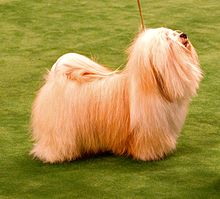Havanese
 |
||||||||||||||||||||||||||
| Other names | Havanese Cuban Bichon Youcef Sorry Bichon Havanês Havaneser Havanezer Bichon Habanero |
|||||||||||||||||||||||||
|---|---|---|---|---|---|---|---|---|---|---|---|---|---|---|---|---|---|---|---|---|---|---|---|---|---|---|
| Origin | Cuba (AKC)/Western Mediterranean Region (FCI) | |||||||||||||||||||||||||
| Patronage | FCI | |||||||||||||||||||||||||
|
||||||||||||||||||||||||||
|
||||||||||||||||||||||||||
| Domestic dog (Canis lupus familiaris) | ||||||||||||||||||||||||||
| Traits | |||
|---|---|---|---|
| Weight | 7–14 lb (3–6 kg) | ||
| Height | 23–27 cm (9–11 in) | ||
| Coat | Very soft double coat (coat is actually hair not fur) | ||
| Color | All colors | ||
| Life span | 14-16 years | ||
| Classification / standards | |||
|---|---|---|---|
| FCI | Group 9, Section 1.1 Bichons #250 | standard | |
| AKC | Toy | standard | |
| ANKC | Group 1 (Toys) | standard | |
| CKC | Group 5—(Toys) | standard | |
| KC (UK) | Toy | standard | |
| NZKC | Toy | standard | |
| UKC | Companion | standard | |
The Havanese, a breed of Bichon type, is the national dog of Cuba, developed from the now extinct Blanquito de la Habana ("little white dog of Havana"). The Blanquito descended from the also now extinct Bichon Tenerife. It is believed that the Blanquito was eventually cross-bred with other Bichon types, including the Poodle, to create what is now known as the Havanese. Sometimes referred to as "Havana Silk Dogs", this was originally another name for the Blanquito de la Habana.
The Havanese is small in size and sturdy in structure with a tail carried over its back and ears that drop and fold. The coat is abundant, long, and silky and comes in all colors. The Havanese has a spirited personality and a curious disposition, and is notable for its springy gait, a characteristic that distinguishes the breed from all others. The Havanese is considered an ideal family pet and a true companion dog. They are highly adaptable to almost any environment. Because of their strong social needs, Havanese will not thrive in an environment where they are isolated for several hours each day.
While a toy dog, Havanese are sturdy and not overly delicate. Most are 10 to 16 pounds (4.5 to 7.3 kg) and 8.5 to 11.5 inches (22 to 29 cm), with the ideal being 9 to 10.5 inches (23 to 27 cm) at the withers. The body, measured from point of shoulder to point of buttocks, is slightly longer than the height at the withers, giving the dog the appearance of being slightly longer than tall. The length of the body results from the long ribcage, not the loins.
A unique aspect of the breed is the topline, which rises just slightly from withers to croup, creating a topline that is straight but not level. Renowned for their flashy, lively gait, when on the move, their strong rear drive and slightly shorter upper arm produce a springy motion rather than a far-reaching one. The angle of the topline does not change while moving at a natural gait.
The muzzle is full and tapers slightly at the nose. It does not have the appearance of being short or snipy. Length of skull measured from stop to point of occiput is equal to the length of muzzle. The top of the skull is rather flat and the backskull is rounded.
The length from foot to elbow is equal to the length from elbow to withers. The forechest is pronounced. When in a standing position, the sternum lines up with the elbows, creating a deep chest. Ribs are well-sprung and the abdomen is moderately tucked up.
The Havanese has dark brown eyes and almond-shaped lids surrounded by black pigment. The ears, when extended, reach half way to the nose. They arc slightly upward at the base and hang down on the sides of the head without touching the face. The tail is carried arched forward up over the back. While the tail's long plume of hair falls on the body, the tail itself never touches the back.
...
Wikipedia
